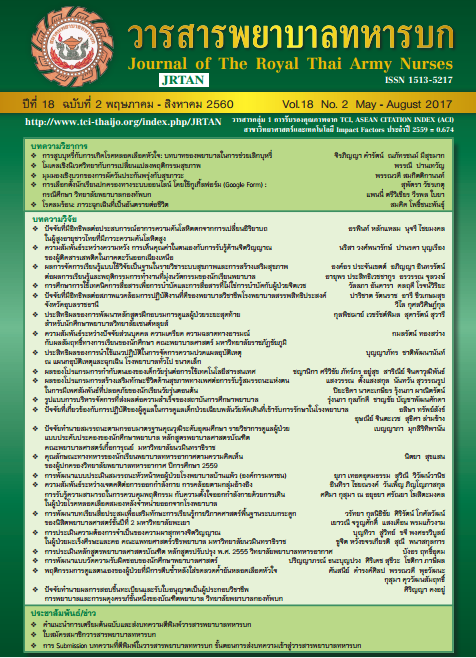ปัจจัยที่เกี่ยวข้องกับการปฏิบัติของผู้ดูแลในการดูแลเด็กป่วยเฉียบพลัน วัยหัดเดินที่เข้ารับการรักษาในโรงพยาบาล
Keywords:
การปฏิบัติของผู้ดูแลในการดูแลเด็กป่วยเฉียบพลัน, ประสบการณ์การดูแลเด็กป่วย, ความวิตกกังวล, การสื่อสารระหว่าง พยาบาลและผู้ดูแล, เด็กป่วยเฉียบพลันวัยหัดเดิน, caregiver practices/ toddlers care, the experience of caring of sick child, anxiety, communication bAbstract
การศึกษานี้เป็นการวิจัยเชิงพรรณนาหาความสัมพันธ์มีวัตถุประสงค์เพื่อศึกษาการปฏิบัติของผู้ดูแลในการดูแลเด็กป่วย เฉียบพลันวัยหัดเดินที่เข้ารับการรักษาในโรงพยาบาลและความสัมพันธ์ระหว่างชนิดการรักษาที่เด็กป่วยได้รับประสบการณ์การดูแล เด็กป่วย ความวิตกกังวล และการสื่อสารระหว่างพยาบาลและผู้ดูแลกับการปฏิบัติของผู้ดูแลในการดูแลเด็กป่วยเฉียบพลัน กลุ่ม ตัวอย่างคือผู้ดูแลเด็กป่วยเฉียบพลันวัยหัดเดินที่เข้ารับการรักษาในโรงพยาบาลระดับตติยภูมิ2 แห่งในภาคเหนือ จำนวน 85 ราย รวบรวมข้อมูลโดยใช้แบบสอบถามข้อมูลทั่วไป แบบประเมินการปฏิบัติของผู้ดูแลในการดูแลเด็กป่วยเฉียบพลัน แบบประเมินการ สื่อสารระหว่างพยาบาลและผู้ดูแลและแบบประเมินความวิตกกังวลต่อสถานการณ์วิเคราะห์ข้อมูลด้วยสถิติพรรณนาสัมประสิทธิ์ สหสัมพันธ์เพียร์สัน สัมประสิทธิ์สหสัมพันธ์อันดับสเปียร์แมน และสัมประสิทธิ์สหสัมพันธ์พอยท์ไบซีเรียล ผลการวิจัยพบว่า ผู้ดูแลปฏิบัติในการดูแลเด็กป่วยเฉียบพลันโดยรวมและรายด้านในระดับมาก ปัจจัยที่มีความสัมพันธ์ กับการปฏิบัติคือ ความวิตกกังวล (r = -.214, p < .05) และการสื่อสารระหว่างพยาบาลและผู้ดูแล (r = .430, p < .01) ผลการวิจัยนี้สามารถนำไปเป็นข้อมูลพื้นฐานในการวางแผนการดูแลเด็กป่วยเฉียบพลันที่เข้ารับการรักษาในโรงพยาบาล และครอบครัว โดยการพัฒนาการสื่อสารระหว่างพยาบาลและผู้ดูแล การลดความวิตกกังวลของผู้ดูแล เพื่อให้ผู้ดูแลปฏิบัติในการ ดูแลเด็กป่วยได้เหมาะสมและมีประสิทธิภาพ
Factors Related to Caregiver Practices in Caring for Hospitalized Toddler with Acute Illness
This descriptive correlationresearchaimed tostudy factors related tocaregiver practices incaring for hospitalized toddlers with acute illness, and to study the relationship of the medical regimen, the experience of caring of sick child, anxiety, and the communication between nurses and caregivers to caregivers’ practice of caring for a child with acute illness. The samples were 85 caregivers who were providing care for toddlers with acute illness and admitted to a pediatric general ward, 2 tertiary hospitals, northern Thailand. Research instruments included sociodemographic, the practices of caregiver on acute illness questionnaire, the communication between nurses and caregiver’s questionnaire, and the State-Trait Anxiety Inventory Form Y-1 (STAI Form Y-1). Data were analyzed byusing descriptive statistics, Pearson product-moment, Spearman’s rank correlation coefficient, and the point-biserial correlation coefficient. The results showed caregivers’ overall mean scores of practices in caring for hospitalized toddlers was at a high level. A significant negative correlation was found between anxiety and the practice of caregiver incaringforhospitalized toddlers, (r = -.214, p < .05),and communication betweennursesand caregiver showed statistically significant positive relationship to caregivers’ practice of caring for hospitalized toddlers (r = .430, p < .01). The results of this study serve as preliminary information about caregiver practice in caring for hospitalized toddlers and related factors. It may beused as guidelines in planningnursing careof children with acute illness and their families
Downloads
Downloads
How to Cite
Issue
Section
License
บทความหรือข้อคิดเห็นใดใดที่ปรากฏในวารสารพยาบาลทหารบกเป็นวรรณกรรมของผู้เขียน ซึ่งบรรณาธิการหรือสมาคมพยาบาลทหารบก ไม่จำเป็นต้องเห็นด้วย
บทความที่ได้รับการตีพิมพ์เป็นลิขสิทธิ์ของวารสารพยาบาลทหารบก
The ideas and opinions expressed in the Journal of The Royal Thai Army Nurses are those of the authors and not necessarily those
of the editor or Royal Thai Army Nurses Association.






